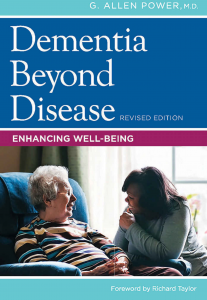“I believe dementia is the greatest shame of modern medicine; not because there have been no significant advances in treatment, but because – from restraints, to locked units, to antipsychotics, to ECT – we have lost our recognition of the humanity of those living with the diagnosis. And there are few signs that we are making much headway in this regard.“
– Author, Al Power, MD, FACP, Internist and Geriatrician
Summary of timeline
1975 – The film, “One Flew Over the Cuckoo’s Nest” with Jack Nicholson, is based on a 1963 book by Ken Kesey with a setting in an Oregon facility in the 1950’s when lobotomy was practiced.
2001 – Dad was admitted to a regional medical center “for observation.” The next morning, we found him tied in a chair and physically restrained. He had been administered Depakote – a chemical restraint. We were informed that he would be transferred to the geri-psych unit later that morning.
2017 – Second Edition of Dementia Beyond Drugs: Changing the Culture of Care. “2010 Book of the Year Award” from the American Journal of Nursing (First edition, 2010), Author G. Allen Power, MD
2017 – Revised Edition of Dementia Beyond Disease – Enhancing Well-Being. Author G. Allen Power, MD
2019 – Author G. Allen Power, MD, posts article about an NIA-funded study which uses ECT (ElectroConvulsive Therapy) for people living with dementia.
2020 – Author G. Allen Power, MD, updates the results of Dr. Angela Norman’s work using his “Well-Being Approach to Distress.”
Expanded chronology:
1975 – The setting of the film, “One Flew Over the Cuckoo’s Nest” with Jack Nicholson, was a 1950’s psychiatric hospital where the practice of lobotomy was being used. Nurse Ratched represented the way society treated those with mental illness. During graduate studies in the 70’s, I found a description of her as representing the patriarchal hospital. According to a more recent reviewer, “She doesn’t know she’s evil and believes she’s helping people.” She kept the patients in her psychiatric unit “in line” by using abuse, medication and sessions of electroconvulsive therapy. Official trailer here.
2001 – Dad – a candidate for a geriatric-psychiatric unit? Really …?!
 Upon finding Dad tied to his chair in restraints, we were informed by a nurse that he was scheduled to be transferred to the geri-psych (geriatric-psychiatric) unit later that morning.
Upon finding Dad tied to his chair in restraints, we were informed by a nurse that he was scheduled to be transferred to the geri-psych (geriatric-psychiatric) unit later that morning.
The evening before – against my own judgment and under extreme duress, I had relented for Dad to be admitted to a neurology unit at one of our regional medical centers for a one-night stay. Reason for admission? It followed a neurological event (TIA or seizure) which occurred as we were about to exit the building following a physician visit. I was told the admission would be “for observation.” A brusque ER physician in the fast-moving emergency department gave me no options and said sternly that I would be responsible if anything happened to him.
The next morning, Mother and I found him in a very agitated state, speaking gibberish, and fighting to remove the restraints which tied his wrists to the chair in which he was sitting. He had been moved to a room just a few feet from a nursing module, much closer than where we left him at a very late hour the night before. The RN working at the module told us that he was about to be transferred to a geri-psych unit (geriatric-psychiatric) that morning.
We entered his semi-private room and, without hesitation, un-tied his restraints. After helping him get dressed, we informed the RN we would be waiting for discharge in the solarium. What else was there to say? Upon our arrival, the gibberish and agitation had immediately stopped.
Stunned and speechless
Walking out of the dark neurology unit, we entered a beautiful, bright public solarium. The three of us waited quietly together with Dad sitting between us. I was stunned and speechless by what we had just experienced.
What was my father feeling? In retrospect, I believe he felt safe again as he sat, alert and quiet, between us. He had, after all, just come through a fight for his life. In this traumatic circumstance, he had completely lost his ability to speak. And so had I.
 Our three-hour wait in the solarium was broken up by the neurology department manager introducing herself as one of Mother’s former second grade students. We both remembered her, since I had visited Mother’s classroom during college breaks – and subsequently, she had talked about what a good student she was as she graded papers in the evening. I like to think that, in spite of the circumstances which left me otherwise without words, our conversation with her had passed a lucidity test.
Our three-hour wait in the solarium was broken up by the neurology department manager introducing herself as one of Mother’s former second grade students. We both remembered her, since I had visited Mother’s classroom during college breaks – and subsequently, she had talked about what a good student she was as she graded papers in the evening. I like to think that, in spite of the circumstances which left me otherwise without words, our conversation with her had passed a lucidity test.
I fleetingly considered the possibility that we all might have been involuntarily committed to the Geri-Psych unit! Indeed, Dad had not yet been formally discharged. And I was certainly not responding in an expected conventional way when it came to decisions being made about us – and without us! Assignment to a geri-psych unit without discussion?! … A plain and simple “no.”
How much worse could a geri-psych unit be than the semi-dark, semi-private room where we found Dad tied to his chair trying to release his wrists – next to a younger man frothing at the mouth? I did not want to find out.
I was having flashbacks to the environment depicted in “One Flew Over the Cuckoo’s Nest” with Jack Nicholson.
My past experience was helpful in regard to not being intimidated – or overly-impressed – in the beautiful Taj Mahal lobby and atrium, which every regional medical center now has – where all eventually lead into the darker corridors. And, of course, I was comfortable being among healthcare workers.
In earlier years …
I had worked in three major medical centers in Chicago where I had easy access to all nursing units in order to speak with nurses about matters related to recruitment and retention …
I had represented the Illinois Hospital Association in my role as a consultant with a small national consulting firm, calling upon hospital CEO’s throughout the Midwest and up and down both coasts of Florida. Every medical center I visited had a similar Taj Mahal lobby – or was in the process of building one, in which case, I often walked through construction dust while it was being built.
And, by this point, I currently had my own physician consulting firm, interfacing with CEO’s of multi-hospital systems, physicians, and universities.
So – waiting in the lobby for three hours – well, I had never waited that long for my next appointment, but – no problem. Mother (age 84) and Dad (age 85) were fine – seated quietly next to each other, both wide-eyed and very alert the entire time.
But there was this uneasy feeling I still had until we drove away. Since Dad’s admission to a Geri-Psych unit had been imminent only moments before, exactly why had we not been part of the conversation to discuss his being moved there? Is it possible he could have been transferred without our input and consensus? This question continued to perseverate while we waited.
Finally, three physicians came to speak with us. We were six – all standing together in the center of the busy solarium. One was a resident and one was from the practice of which Dad’s neurologist was a member. The resident said, in the presence of my father, “We pumped him full of Depakote.” Impersonally spoken and showing no compassion, the resident’s words might have been about an inanimate object rather than about Dad.
No formal discharge …?
Had the other two physicians spoken, I would remember! Had we been given discharge papers to sign, we would have signed! Had we been provided a wheelchair to the door for Dad, we would have accepted!
Upon the conclusion of this brief stand-up meeting with the physicians, we turned toward the exit, most likely appearing as three mutinous renegades as we walked away with Dad between us. If anything were to happen to him, as I was cautioned by the ER physician the night before, I would take that risk and bear the responsibility. But, indeed, nothing like that was spoken today.
A (more) dignified life
 Without overstating my strong response under these circumstances, it became a moral imperative to remove Dad from the threat of ever being tied up in restraints again in either the dark neurology unit – or the dark corners of a geri-psych unit. Admission to this environment for our high-spirited, independent and very private parents would almost forever elude us. They belonged together, so long as we could all manage together.
Without overstating my strong response under these circumstances, it became a moral imperative to remove Dad from the threat of ever being tied up in restraints again in either the dark neurology unit – or the dark corners of a geri-psych unit. Admission to this environment for our high-spirited, independent and very private parents would almost forever elude us. They belonged together, so long as we could all manage together.
First do no harm
The medical center was now in our rear view mirror as we headed back to the ranch. We simply would not be candidates for this depersonalizing and disrespectful care.

But first, we would make a stop at what had always been a favorite restaurant located along the river-front. We had not had lunch and it would be mid-afternoon by the time we reached the ranch.
Some comfort food would be nice – perhaps a bowl of chowder or gumbo before their afternoon naps. The late business lunch crowd was still seated, but the hostess pleasantly greeted us and found the perfect table for three. What a difference the 15-minute drive made!
Does healthcare with its Taj Mahal lobbies and atriums have something to learn from the hospitality industry?
Where had the regional medical center let us down? When we reluctantly agreed to admission “for observation,” we thought it was “for observation.”
- The patriarchal attitude throughout this event – beginning with the ER physician at the time of admission on the previous evening.
- The physical restraints and chemical restraints used overnight.
- The decision to transfer Dad to geri-psych without our input.
- The disregard for patient privacy in the open discussion about Dad’s “treatment” which occurred in a busy public lobby with people seated all around us.
- Overall, Dad’s depersonalizing and dehumanizing treatment!
Why would we ever have expected that – once transferred to another unit – Dad’s care would be any different than what we had just experienced?!? Indeed – brief though it was – the 20-hour experience was an adequate amount of time on which to base our strong desire to be discharged!

2012 – I did not participate in the class action suit over the use of Depakote – determined to be illegally misbranded for agitation and aggression in elderly dementia. However, a US attorney described it as an “elder abuse case.” It is the pharmaceutical about which the medical resident said with no feeling, “We pumped him full of Depakote.” [This event is described here at greater length: Big Pharma and the Constant Gardener]
A Gentler, More Humane Approach
 2017 – Second Edition of Dementia Beyond Drugs: Changing the Culture of Care. “2010 Book of the Year Award” from the American Journal of Nursing (First edition, 2010). Author G. Allen Power, MD, FACP, Internal Medicine and Geriatrics, and international educator.
2017 – Second Edition of Dementia Beyond Drugs: Changing the Culture of Care. “2010 Book of the Year Award” from the American Journal of Nursing (First edition, 2010). Author G. Allen Power, MD, FACP, Internal Medicine and Geriatrics, and international educator.
2017 – Revised Edition of Dementia Beyond Disease – Enhancing Well-Being. Author G. Allen Power, MD, FACP, Internal Medicine and Geriatrics, and international educator.
2019 – G. Allen Power, MD, FACP, Internal Medicine and Geriatrics, author, and international educator, contributed a February 2019 post to “Dementia Action Alliance Now” – daanow.org. He wrote about an NIA grant in the amount of $11.8 million, funded to test ECT on people living with Alzheimer’s.
According to Dr. Power’s article, “ECT is being used on a total of 200 people living with Alzheimer’s disease who have been referred to five geri-psych inpatient centers.”
He states: “I describe the practice of ECT as Twenty-first Century Lobotomy.”
The institutions associated with the study are highly-regarded – which is, in itself, unsettling. Having worked with candidates from their respective residency programs gives me pause: How can the use of ECT’s with people living with Alzheimer’s be justified? Where is the humanity?
Understanding “behaviors” as “unmet needs” – a course for medical and nursing staff

When fighting to get out of his restraints, had Dad’s behavior simplistically been perceived by medical staff as “non-compliance” with their protocol? What a sad lack of understanding about Dad! And what a sad lack of understanding about dementia care!
In reality, he had a high regard for authority, including all previous medical care up to this point. In this moment, I believe he was fighting for his life and unable to speak during this traumatizing event.
Restraints were not a part of the ranch milieu. Spirited and feisty in his earlier years, Dad appeared peaceful and grateful at the ranch. I have frequently noted in journals how he and mother often expressed gratitude. At the ranch, my parents responded to others in the same manner in which they were treated.
This was also occasionally observed by one of our care partners when speaking about both parents. This is significant because this care partner was an active, energetic 80-year-old, under 5′ tall, 100 pounds – who dearly loved my parents. Remarkably, she continued with us over a 10-year period, during which time, the two of us never had a need to restrain my parents, physically or chemically.
The subjects on whom ECT is tested in the NIA study have the same diagnosis and are from the very same “specialty care unit” to which Dad was about to be transferred – geri-psych.
2019 Results of Dr. Angela Norman’s Work Using the “Well-Being Approach to Distress”
In Dr. Power’s February 2019 article, he wrote: “Dr. Angela Norman and her team from the Arkansas Health Care Foundation have launched a large initiative to employ the ‘Well-Being Approach to Distress’ that I teach in their state’s long-term care communities.“
His comments on the early results of using the “Well-Being Approach” follow:
“Consider the implications of this: These people whose well-being has been improved, and who have been kept off of drugs and out of inpatient treatment in Arkansas are the same kinds of people to whom the NIA study will be applying multiple courses of ECT in Michigan, Minnesota, New York, Massachusetts, and Georgia. This suggests that many, if not most of the study subjects will be getting an invasive, potentially harmful treatment that would have been unnecessary if living in an environment using more innovative approaches.” To read full article on Dementia Action Alliance website, find it here.
September 2020 update from Dr. Power – Admissions reduced by 75% across 66 homes in 2019 – impressive results!
“I have talked about it a lot lately, in terms of what Dr. Angela Norman and her group have done with the ‘Well-Being Approach’ in Arkansas. The results show a reduction of antipsychotic use to 6.7% across 92 nursing homes from 2018-2019, and a decrease in geri-psych admissions by 75% across 66 homes in 2019. The latter is critical, because geri-psych is the referral source for the ECT study …
If those individuals residing in Dr. Norman’s facilities were being treated with Dr. Power’s “Well-Being Approach,” it is unlikely they would have “qualified” as “subjects” for the ECT study.
Why? The results show that using this gentler, more humane approach has decreased the admissions to geri-psych units by 75% in 66 homes in one year. Again, geri-psych units are the units from which this study draws its participants.
On this final day of Dementia Awareness Month 2020, it is apparent – we have only just begun. Awareness and education programs must awaken providers to the urgent need for more humane care of people living with dementia.
“Care partners and family members tell me nothing has changed. People newly diagnosed with dementia tell me nothing has changed. Reports, survey findings and publications consistently confirm nothing has changed.” Kate Swaffer, KateSwaffer.com
Find Dr. Power’s books on Amazon
 Find here on Amazon:
Find here on Amazon:
2017 – Second Edition of Dementia Beyond Drugs: Changing the Culture of Care. “2010 Book of the Year Award” from The American Journal of Nursing (First edition, 2010). Author, G. Allen Power, MD

Find here on Amazon.
2017 – Revised Edition of Dementia Beyond Disease – Enhancing Well-Being, Author, G. Allen Power, MD
Author: Susan Troyer




Leave A Comment